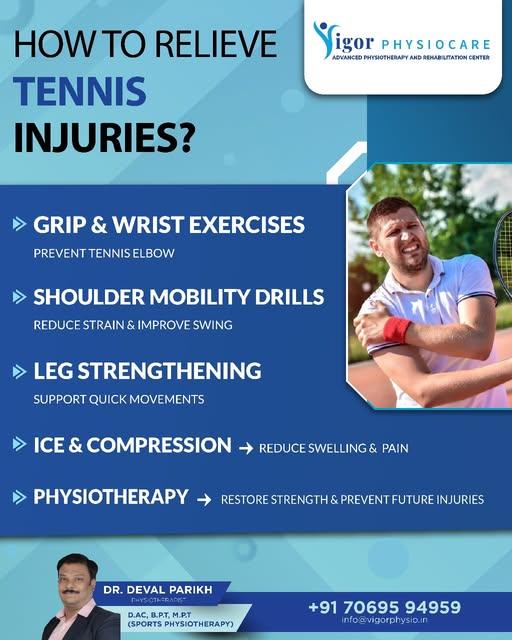Tennis elbow, or lateral epicondylitis, is a common condition that affects not only athletes but also individuals engaged in repetitive arm and wrist movements. From IT professionals and chefs to painters and carpenters—this overuse injury doesn’t discriminate. When the pain becomes persistent or interferes with daily activities, seeking help from the best physiotherapist in Ahmedabad can be a crucial step towards recovery.
Understanding Tennis Elbow
Tennis elbow occurs due to overuse of the forearm muscles and tendons, particularly the extensor carpi radialis brevis. These muscles control wrist extension and are repeatedly engaged in gripping, lifting, or twisting motions. The continuous strain causes micro-tears in the tendons, leading to inflammation and pain on the outside of the elbow.
While it’s named after the sport, tennis players account for a small fraction of cases. Most individuals develop the condition through repetitive occupational or household activities. It is most common among adults aged 30 to 50.
Early Signs and Symptoms
Recognizing the symptoms early can prevent the condition from worsening. Key symptoms include:
-
A dull ache or sharp pain on the outer part of the elbow
-
Pain that worsens with gripping, lifting, or twisting
-
Weakness in the wrist and forearm
-
Stiffness or difficulty extending the arm
Initially, the discomfort may be mild and intermittent, often brushed off as muscle fatigue. However, ignoring these early warning signs can lead to chronic pain and prolonged recovery.
When Does Tennis Elbow Become Chronic?
Tennis elbow is typically categorized as chronic when pain persists for more than 6-8 weeks despite rest and home remedies. At this stage, the condition often involves more than just inflammation—it may include degeneration of the tendon tissue, known as tendinosis. This is when conservative management becomes essential.
If you experience the following, it’s time to consult the Best Sports Physiotherapists in Ahmedabad:
-
Pain lasting more than two months
-
Increasing discomfort despite rest and over-the-counter medication
-
Difficulty performing daily tasks like turning a doorknob or lifting a kettle
-
Decreased grip strength
-
Worsening pain with repetitive wrist or elbow movements
Chronic tennis elbow should not be ignored. Delayed intervention may lead to tendon rupture or permanent weakening of the muscle.
How Can Physiotherapy Help?
Physiotherapy plays a pivotal role in the non-invasive treatment of chronic tennis elbow. A structured physiotherapy program addresses pain, restores movement, and improves muscle strength and flexibility. Here's how it works:
1. Pain Management
Physiotherapists employ various modalities like:
-
Ultrasound Therapy: Helps reduce inflammation deep in the tissues.
-
Laser Therapy: Promotes cell regeneration and healing.
-
TENS (Transcutaneous Electrical Nerve Stimulation): Alleviates pain by stimulating the nerves.
Manual therapy and gentle massage are also often used to increase blood flow and decrease stiffness.
2. Exercise Therapy
Once pain is under control, targeted exercises are introduced to stretch and strengthen the forearm muscles and tendons. These include:
-
Eccentric strengthening: Controlled lengthening of the muscle under tension, particularly effective in treating tendinopathies.
-
Wrist and forearm stretches: Improve flexibility and reduce stiffness.
-
Grip strengthening: Helps restore lost strength and function.
A personalized exercise regimen is key to a full recovery and preventing recurrence.
3. Ergonomic Advice
Physiotherapists also assess your work and lifestyle habits. Whether it’s your desk setup, sports technique, or cooking posture, small adjustments can significantly reduce strain on the affected area.
4. Dry Needling and Taping
In some cases, physiotherapists may use advanced techniques like dry needling to release trigger points or kinesiology taping to support the injured tendons and reduce stress.
Benefits of Early Physiotherapy Intervention
Timely physiotherapy can shorten the healing timeline significantly. It also:
-
Prevents further tendon damage
-
Restores functional use of the arm and wrist
-
Reduces reliance on medications
-
Minimizes risk of surgical intervention
-
Improves overall quality of life
Delaying treatment often results in compensatory movement patterns that can lead to other musculoskeletal issues such as shoulder or neck pain.
What Happens If You Ignore It?
If chronic tennis elbow goes untreated, you may experience:
-
Constant elbow pain, even at rest
-
Loss of function in daily activities
-
Sleep disturbances due to pain
-
Dependency on the other arm, leading to overuse injuries
In severe cases, surgery may be required to remove damaged tendon tissue. Recovery from surgery can take months and involves extensive rehabilitation. That’s why seeking Tennis Elbow Pain Treatment in Ahmedabad at the right time is so important.
Preventing Tennis Elbow
After recovery, prevention is just as crucial. Here are a few tips:
-
Warm up properly before activities involving repetitive arm motions
-
Use ergonomic tools and maintain proper posture
-
Incorporate regular forearm strengthening and stretching into your routine
-
Avoid overloading your wrist and elbow
-
Take regular breaks during repetitive tasks
A physiotherapist can also educate you on proper biomechanics and body mechanics to prevent recurrence.
Conclusion
Chronic tennis elbow doesn’t have to be a long-term struggle. With timely intervention, the right treatment, and guided rehabilitation, you can regain pain-free function and return to your daily routine or sport. If you're experiencing ongoing elbow pain and suspect it might be more than a simple strain, don’t delay getting professional help. A qualified physiotherapist can guide you on the most effective path to recovery.
Whether you're an athlete, office worker, or someone dealing with repetitive hand use, addressing the problem early is your best bet. Reach out to experienced professionals who specialize in musculoskeletal injuries to ensure you get the personalized care you need.



